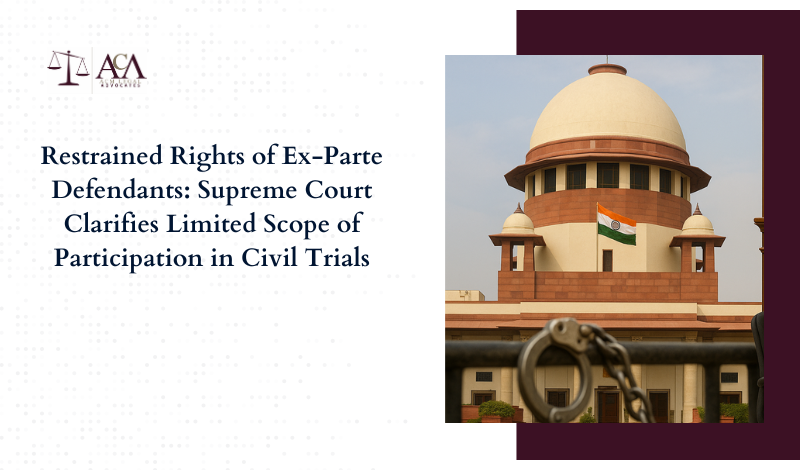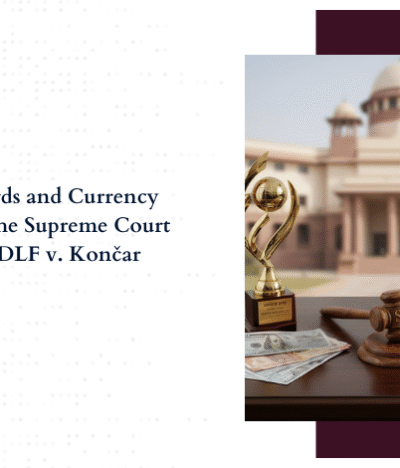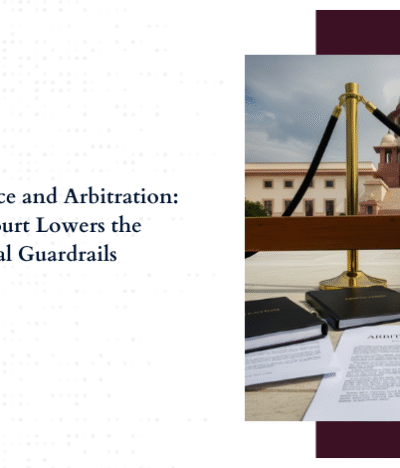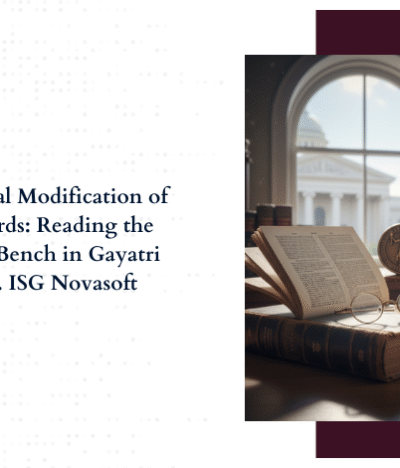Supreme Court Clarifies Rights of Ex-Parte Defendants in Civil Trials
In a recent landmark ruling clarifying the rights of ex-parte defendants, the Supreme Court of India, in Civil Appeal No. 5319 of 2025 [arising out of SLP(C) No. 20978 of 2024], revisited the legal consequences of default in civil litigation. The Court decisively held that a defendant who has been set ex-parte in a civil suit cannot lead evidence in their defence and is limited only to the right of cross-examining the plaintiff’s witnesses—if they are present at the time of examination. The judgment, titled Kanchhu vs. Prakash Chand & Ors., was delivered on April 22, 2025, by a two-judge bench comprising Justice Dipankar Datta and Justice Manmohan. It set aside an erroneous High Court intervention under Article 227 of the Constitution of India, reinforcing the procedural boundaries governing the participation and rights of ex-parte defendants in civil trials.
Facts Of The Matter
The litigation commenced when the appellant (Kanchhu), as plaintiff, filed Suit No. 105 of 1987 on 22nd May, 1987 before the Court of Munsif, Khurja, District Bulandshahr, Uttar Pradesh, seeking cancellation of a registered sale deed (bearing No. 5179, dated 05th September, 1984) on the grounds of fraud. The disputed property measured over 6 bigha 5 biswa. The respondents, being defendants and the appellant’s own brothers, were alleged to have procured the transfer by dishonest means.
Despite filing their written statement on 18th September, 1987, the respondents continuously sought adjournments, leading to the trial court setting them ex-parte on 24th April, 1991. Subsequently, the plaintiff’s evidence was recorded on 2nd July, 1991, with no cross-examination from the defendants. Arguments were heard on 6th August, 1991, and an ex-parte decree was passed on 17th August, 1991 in favour of the appellant.
Following the decree, the respondents filed an application under Order IX Rule 13 of the Code of Civil Procedure, 1908, accompanied by a plea under Section 5 of the Limitation Act, 1963, seeking to set aside the ex-parte decree. However, their application for condonation of delay was rejected on 3rd November, 1997, resulting in dismissal of the Miscellaneous Case. Upon revision, the High Court allowed the delay condonation by order dated 19th April, 1999, remanding the matter for disposal on merits.
The trial court again dismissed the Order IX Rule 13 application on 23rd July, 2002, and the District Judge, Gautam Budh Nagar, by order dated 8th October, 2002, dismissed the Miscellaneous Civil Appeal No. 52 of 2002, confirming that no sufficient cause had been shown for absence.
The appellate order was carried in a writ petition [Writ C No.378 of 2003]. Initially dismissed as infructuous on 1st December, 2011, the High Court later recalled this order on 5th June, 2018, after a delay of over six and a half years, and went on to set aside the ex-parte decree, reviving the suit.
The Supreme Court’s reversal of this High Court ruling has now reasserted the binding principles of procedural discipline, particularly where defendants are set ex-parte for persistent absence and lack of due diligence.
Key Legal Issues and Arguments Before the Court
The solitary legal issue which arose for adjudication before the Supreme Court was articulated as follows:
“Whether the High Court was justified on facts and in law to allow the writ petition of the respondents in the manner it did?”
This precise formulation of the central legal question was critical in assessing the limits of High Court’s supervisory jurisdiction under Article 227 of the Constitution.
Submissions by the Appellant
Mr. Partha Sakha Datta, learned senior counsel for the appellant, assailed the High Court’s impugned judgement dated 1st May, 2024 as being vitiated by erroneous legal standards and lacking judicial propriety. He contended that:
- The High Court had transgressed its supervisory jurisdiction by virtually exercising appellate powers, setting aside a long-finalized ex-parte decree.
- It did so without examining the specific cause shown by the respondents for their absence during trial proceedings.
- The writ court failed to engage with the factual matrix, including repeated adjournments sought by the respondents and their failure to cross-examine or contest the plaintiff’s evidence.
In his submissions, Mr. Datta emphasized that vigilance and diligence, which are cornerstones of civil litigation, were egregiously absent in the conduct of the respondents.
Contentions by the Respondents
Mr. Sukumar Pattjoshi, learned senior counsel for the respondents, urged the Court to consider the equities of the situation, submitting that:
- The respondents had missed their opportunity to defend the suit due to reasons beyond their control, particularly claiming that they were not informed by their lawyer about the dismissal of their writ petition as infructuous in 2011.
- The ex-parte decree, in his submission, had denied the respondents a fair trial, and the High Court rightly exercised discretion to revive the suit and ensure substantive justice.
His arguments, though emotional in appeal, were counterbalanced by the Supreme Court’s scrutiny of the record, which revealed an extended and inexcusable pattern of non-participation by the respondents, even prior to the alleged illness and legal miscommunication.
Observations by the Supreme Court
The Supreme Court of India, speaking through Justice Dipankar Datta, delivered a detailed and sharply reasoned judgement, underscoring the limits of judicial interference where litigants fail to demonstrate sufficient cause for setting aside an ex-parte decree.
At the outset, the Court acknowledged that though the recall application was filed after a delay of 7 years, the High Court had condoned the delay upon accepting the explanation that the respondents’ lawyer had failed to inform them about the dismissal of their writ petition. While the Supreme Court indicated that such a delay would ordinarily defeat the recall, it nonetheless took a lenient view “having regard to the explanation proffered by the respondents” and assumed arguendo that the High Court was justified in condoning the delay and restoring the writ petition.
However, the Supreme Court categorically held that the real error lay in how the High Court allowed the writ petition:
- The High Court failed to consider the grounds stated in the application under Order IX Rule 13, CPC, and also ignored the findings of the trial court (dated 23rd July 2002) and appellate court (dated 8th October 2002) which had rejected the application to set aside the ex-parte decree.
- The High Court, without proper jurisdiction, set aside the ex-parte decree on merits, stating:“The court ought to have considered the written statement and defence taken therein… There has to be proper adjudication and only then it can be said that to be formal declaration of judgement to fall within the meaning of Section 2(2) of C.P.C.”
The Supreme Court rebuked this approach, holding that:
“In exercise of jurisdiction under Article 227 of the Constitution, the learned Judge was required to examine whether the respondents had shown sufficient cause for staying away… not to reassess the merits of the decree as if sitting in appellate jurisdiction.”
The bench emphasized the procedural reality that once a defendant is set ex-parte, his rights are limited—he may cross-examine the plaintiff’s witnesses, but cannot produce evidence in defence. This core principle was violated by the High Court, which appeared to rely upon the written statement as if it had been proved by evidence.
Furthermore, the Court highlighted the respondents’ failure to substantiate their illness, which was claimed to have lasted from 15th August 1991 to 30th November 1991, by:
- Not examining the doctor who issued the certificate.
- Not entering the witness box to prove the claim.
- Not explaining their absence from proceedings prior to 15th August 1991, including the dates 24th April 1991, 2nd July 1991, and 6th August 1991—which were crucial as the respondent No.1’s illness had not yet occurred.
“The cause shown falls much short of an explanation and we are inclined to view it as nothing but a lame excuse.”
The Supreme Court also stressed that the plaintiff’s evidence was unchallenged, and the respondents’ repeated adjournment-seeking behavior demonstrated lack of diligence. The ex-parte order passed on 24th April, 1991 was not incidental, but a logical consequence of the respondents’ own conduct.
Legal Position on Rights of an Ex-Parte Defendant
The Supreme Court in this judgement has decisively clarified the limited procedural rights of a defendant who is set ex-parte. This pronouncement is of substantial significance to civil litigation practice and reinforces the doctrine that procedural indiscipline has legal consequences.
The Court emphasized that once a defendant is set ex-parte, the Code of Civil Procedure, 1908, circumscribes his participatory rights. Citing Order VI Rule 2, CPC, the Court held that:
“Pleadings, either in a plaint or a written statement, constitute the plinth on which the respective claims and defence of the parties to a civil suit rest.”
However, where a defendant does not appear despite summons and is proceeded against ex-parte, the following consequences arise:
- Such a defendant cannot adduce evidence in support of his written statement.
- The factual assertions in the written statement remain unproven, as they are not supported by testimony.
- The only viable right retained by such a defendant is the right to cross-examine the plaintiff’s witnesses—but even this is forfeited if the defendant remains absent at the time of evidence.
The Court observed:
“Generally speaking, the limited right that the defendant, set ex parte, would have is confined to cross-examining the plaintiff’s witnesses… the defendant has to convince the court that the case put up by the plaintiff is so false that the court ought not to accept it.”
This distinction was crucial in the case at hand because the respondents, after being set ex-parte on 24th April, 1991, failed to cross-examine the appellant, whose evidence was recorded on 2nd July, 1991 and remained unchallenged. The Court further noted:
“Since the respondents did not cross-examine the appellant, whatever he deposed was believed and accepted.”
The High Court’s approach, which faulted the trial court for not “considering the written statement” while passing the ex-parte decree, was declared legally untenable. The Supreme Court clarified that such a view misconceives the legal position:
“The observations of the learned Judge cannot be countenanced with reference to any provision of law or binding precedent.”
The Court reiterated that even if legal issues such as jurisdiction, limitation, or bar to relief are raised in the written statement, their adjudication is contingent on proper framing and argument—something that cannot happen once a party is set ex-parte, unless the issue is purely legal and apparent on the face of the record.
This section of the judgement therefore sets forth a binding precedent and serves as a guiding principle for civil courts—that merits cannot be revisited when a party, by its own volition or negligence, has defaulted in participation.
Conclusion
In unequivocal terms, the Supreme Court’s judgement in Kanchhu vs. Prakash Chand & Ors. sends a stern message to litigants and courts alike: procedural indifference cannot be condoned in the guise of equitable relief. By setting aside a flawed High Court ruling that had improperly revived a decades-old dispute, the Court reaffirmed the principle that a defendant who is set ex-parte has no unfettered right to reopen concluded proceedings, especially after knowingly abandoning the trial process. The judgement stands as a clear precedent on the limited rights of ex-parte defendants, asserting that civil justice demands both diligence and finality. It is a timely reminder that Article 227 cannot be a tool to undermine judicial discipline or to redress litigants who fail to show even the basic standard of vigilance.






